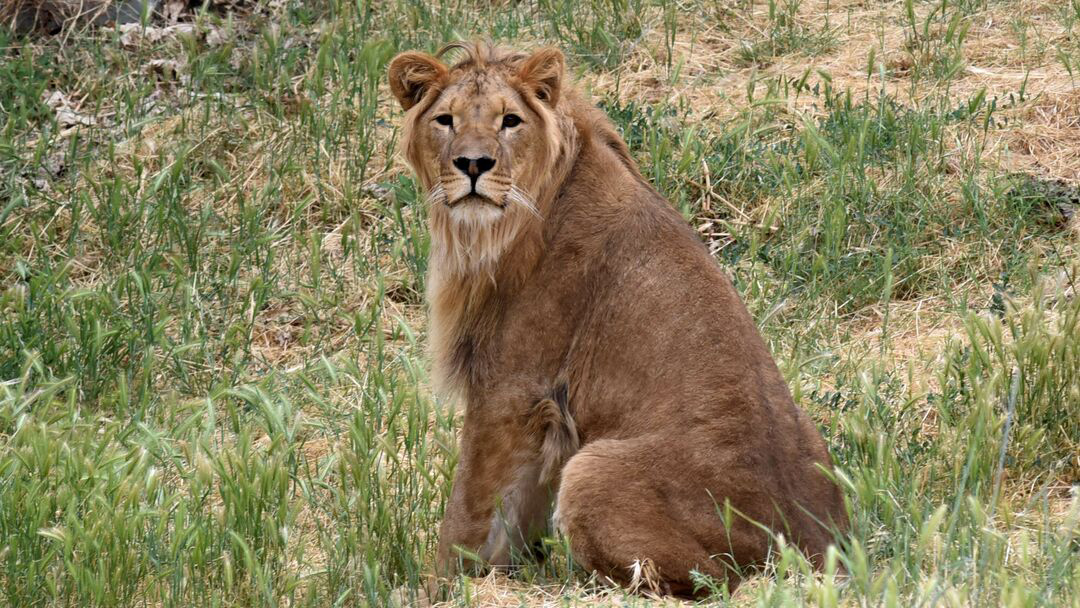Simba: Your questions answered
4 August 2022
SIMBA: YOUR QUESTIONS ANSWERED
Will he be able to go back to the wild? Will he be able to breed? Why is he in Italy? Born Free’s Acting Head of Rescue & Care, Dr Andrea Donaldson, answers your questions!

(c) Giancarlo Grillo
Simba was rescued as a tiny cub, and carefully rehabilitated before he was given his forever home at Animanatura, a wildlife sanctuary in Italy, thanks to generous public support.
Why is Simba at a sanctuary in Italy not South Africa?
At present both sanctuaries which Born Free places animals at in South Africa, Shamwari and partner sanctuary Panthera Africa, are full to capacity and simply do not have the space for one more lion. Animanatura in Italy, have significant experience in caring for rescued big cats and had space available immediately, which meant we could relocate Simba without delay. We felt that a sanctuary located in the Italian Semproniano hills, which has year round warm weather and hot summers with enclosures that include ample space to roam was an excellent option for Simba.
How is a sanctuary any different from a zoo or safari park?
There are many differences between a true sanctuary and a zoo or safari park, but for me the number one most important factor is that the well-being of each individual animal is paramount and their needs are considered a priority above all else.
At Animanatura, Simba will have a first-class sanctuary life. We have plans to build him a purpose-built expansive enclosure in the region of 5000m2, substantially larger than you would find in a zoo.
His enclosure will be designed to fully meet his needs, as far as is possible in a captive setting, including giving him large areas that he can access and be out of sight, he will have privacy and the right to be seen or not as he chooses – again a condition not often given to zoo animals.
His enclosure will be designed to fully meet his needs, as far as is possible in a captive setting, including giving him large areas that he can access and be out of sight, he will have privacy and the right to be seen or not as he chooses – again a condition not often given to zoo animals. Animanatura does not open to the general public which ensures the animals do not become stressed or uncomfortable with too many observers – the animals’ needs always come first, again a policy not given by many zoos or safari parks. Finally, Animanatura do not buy, sell or trade wild animals and have a strict non-breeding policy in place, meaning that valuable spaces for future rescued animals are not filled with unnecessarily captive breed animals.
How do I know Simba is at a genuine sanctuary?
Before Born Free places one of its rescue animals in any sanctuary setting we conduct extensive due diligence. We conduct site visits to the sanctuary and ask extensive questions to ensure that their ethos is in line with Born Free’s. Sadly, there is no legal definition of a sanctuary and not all institutes that call themselves a sanctuary meet our expectations of a sanctuary. We are currently working with one of our sanctuaries to become GFAS accredited. It is a very lengthy process and once successful means that the sanctuary has passed the highest criteria and the governance of the institute is of the best possible standard.
Animanatura is a member of the European Alliance of Rescue centres and Sanctuaries (EARS). EARS is a network that supports and represents rescue centres and sanctuaries across Europe, enabling them to work together to achieve mutual animal welfare and conservation goals.
Will Simba always live alone, or could he share his enclosure with another rescued lion?
We hope that Simba will eventually have a companion. Simba’s new enclosure will be designed in such a way that it can be divided into two spaces. This means that in time, if we help a suitable companion we can conduct a safe and monitored introduction of one or more lions to Simba.
If lions are under threat, why don’t we let Simba breed with a rescued lioness?
Every animal within a sanctuary setting occupies valuable space. We want every space possible to go to an animal in desperate need of a better life and settings. If we allowed our rescued animals to breed, this would reduce the number of future animals we are able to help, and since we do not deem captive-reared lions releasable (see above) this would not benefit wild lion populations.
If Simba is safe at the sanctuary, why are we still raising funds for his care?
Simba is currently in a temporary enclosure at Animanatura. A beautiful spot covering in the region of 5000m2 has been outlined for Simba’s new purpose built enclosure. The cost of this new enclosure alone is estimated at £117,000. In addition to our desire to upgrade Simbas enclosure we are also committed to his lifetime care. It costs us approximately £11,000 per year to provide for Simba in a day to day capacity including food, routine medical treatment and enrichment, and lions can live into their twenties!
How can supporters get involved?
It would be amazing if supporters could donate to our Build Simba a Home appeal, and/or share Simba’s story with family and friends. Furthermore, we encourage people commit never to support the trade in wildlife by avoiding zoos and circuses that use wild animals, and be vocal to others about why you avoid these places. You can keep up to date with how Simba is doing by keeping an eye on Born Free’s social media and publications.
